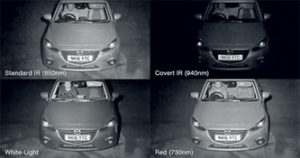
Raytec is a world leader in LED lighting for security and safety applications. In this article, Callum Ryder, Raytec marketing manager, offers his views on lighting requirements for perimeter surveillance systems.
Quality images are a necessity for any security system or transport monitoring application, including perimeter surveillance applications. Not only does the performance of the system rely on the camera and lens, but also on the quantity, quality, and distribution of available light.
“Light determines whether a subject can be viewed at all, and at what distance. The quality and direction of the light also controls the appearance of the subject. However, there are lots of different types and wavelengths of light available and to consider”, states Callum Ryder.
White-light
White-light is one of the most widely used wavelengths of light and is something we’re all used to seeing and using in day-to-day life. A main advantage of using whitelight as part of a security system is its ability to provide colour images, if being used with a colour camera. Identifying the colour of someone’s clothes, hair, or other features, could provide crucial evidence for prosecution.
The defining characteristic of white-light illumination is that it is highly visible to the human eye, hence it’s use for general area illumination. For perimeter surveillance applications, this is also useful when using white-light as a deterrent to ward off potential intruders. On the contrary, if covert surveillance is the aim, white-light illumination is unlikely to be the answer.
Using constant white-light at night may not be suitable for all applications, due to the fact that the target area is lit up, and therefore, potentially assisting an intruder in undertaking a crime. When using white-light, consideration also needs to be given towards light pollution.
“While the use of LED technology means the light can be targeted accurately, some applications may be restricted in their ability to use white-light for environmental reasons such as protecting the night sky or wildlife,” comments Callum Ryder.
Infra-red (850nm)
850nm is a semi-covert light and the preferred choice for most CCTV systems. Security cameras are most receptive to this wavelength of IR and, therefore, it gives the best night-time images. Being semi-covert, the illuminator does give off a slight red glow, visible up close or when looking directly into the light.
“However, for most applications this is not an issue and we would always recommend the use of 850nm over other wavelengths of IR. 850nm will provide the best night-time images and allow the camera to perform at it’s optimum,” says Callum Ryder.
Infra-red (940nm)
940nm is a fully covert wavelength of IR light. A 940nm illuminator does not emit any red glow, making it an option for applications where the red glow from an 850nm light is deemed unacceptable. However, the use of 940nm will mean a significant drop in image quality and achievable distances when compared to an equivalent level of 850nm light. The performance sensitivity of the camera will drop by as much as 50% compared to 850nm.
“If possible, we would always recommend the use of 850nm over 940nm. And when using 940nm, always ensure a suitable camera setup is being used,” comments Callum Ryder.
Hybrid
Another option which specifiers should consider is the use of hybrid illuminators. Hybrid illuminators provide an all-in-one solution, combining both IR (850nm) and white-light into a single unit.
“This means one illuminator can be used for both covert surveillance, and as a white-light deterrent. This is commonly used for perimeter surveillance systems where the end user would like to ward off an intruder before they commit the crime”, explains Callum Ryder.
FAR-RED (730NM)
While unlikely to be relevant for perimeter applications, a wavelength of 730nm (known as ‘Far-Red’), is becoming an increasingly popular choice for transport applications where driver or passenger identification inside the vehicle is required. Modern windscreens are designed to block out certain wavelengths of light. This is mainly to protect the occupants of the vehicle from ultraviolet (UV) rays but is also an attempt to keep the cabin cool by blocking a proportion of infrared (IR) light.730nm is commonly used as less light is blocked by the windscreen.
Seeing through windscreen-test
In tests conducted by Raytec for the purpose of seeing through windscreens, it is clear that 730nm light provides the clearest images to identify the individual within the vehicle, compared to the other wavelengths discussed above. However, a 730nm illuminator does give off an obvious red glow, which could become distracting for drivers in certain cases. ”
In an ideal world, the quality of images produced using 730nm could be achieved using an illuminator which gives off no visible light and, therefore, offers no distraction to the driver. However, in reality, the further down the spectrum one moves, the more light becomes visible to the driver,”concludes Callum Ryder.











